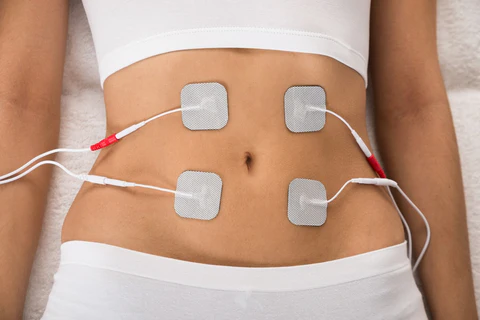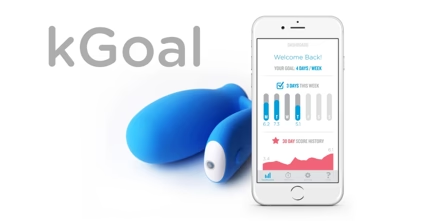What Is Biofeedback Pelvic Floor Therapy?
Published October 11, 2025

If you’ve done any research on pelvic floor muscle exercises, you’ve probably come across the phrase “biofeedback”, often accompanied by the words “training” or “therapy”. But often there is no explanation about what biofeedback is, why and how it is relevant for pelvic floor muscle function, whether there is evidence finding that it actually works, etc. That’s where this article comes in; we’re hoping to provide a quick primer that can get anyone up to speed on the basics in a few minutes.
What is biofeedback?
Biofeedback therapy is a non-invasive, drug-free type of treatment modality in which people learn to measure and control bodily processes (or muscle activity) that are normally involuntary. It may sound complex, but it is simply a method of taking information about something happening in your body where there is no immediate and intuitive cause-and-effect relationship for you to wrap your head around, and presenting it in a way that you can understand. This often involves putting some numbers on the bodily response in question, but can also involve providing some sort of measurement or “feedback” that is easy for you to detect.
Getting on a scale to check your weight is a very simple example of biofeedback. After all, if you gain or lose a few pounds relative to your normal weight, most people can’t detect that without an external measurement tool. Many bodily responses fall into this category, especially ones that can’t be easily seen or otherwise easily detected by our senses (like heart rate or blood pressure).
How does it help with pelvic floor health?
Your pelvic floor muscles are hard to see, and so it’s difficult to get a handle on what’s happening when you try to actuate them. First of all, that can make it surprisingly hard to figure out whether you’re actually using/actuating the correct muscles when you’re exercising. It’s quite common to mistakenly do a muscle contraction involving abdominal muscles or glute muscles instead of pelvic floor muscles and, obviously, if you’re exercising the wrong muscles then you won’t achieve the results you’re hoping for.
Even once you identify the right muscles, it’s not always intuitive to be able to sense how much you’re contracting them (or relaxing them after a contraction). Think of it like wiggling your ears. Those muscles exist in humans -- some people can do it. But many people can’t. They don’t have those muscles mapped to their brain, so to speak. Even a very simple biofeedback system for learning how to wiggle your ears (like a mirror so you can actually see what they’re doing) can help you learn to make those connections and practice using those muscles.
The pelvic floor muscles are similarly tricky for many people to first identify and then practice controlling. Overall, one study found that more than half of the participants were not able to achieve an ideal Kegel effort after standardized verbal instructions, and concluded that “simple verbal or written instruction does not represent adequate preparation” for learning how to do Kegel exercise.
Biofeedback is a way to close that loop. The gold standard is an in-person examination with a pelvic floor physical therapist, who can provide a digital exam and use their fingers to confirm that you’re using the right muscles and the right technique. But if you are not able to see a pelvic floor physiotherapist, or for helping you exercise as effectively as possible when you’re on your own, a biofeedback system can provide a lot of value.
Traditional biofeedback therapy uses visual displays (often on a computer) and sounds to show you the response of the muscles you are exercising. It also allows a clinician to measure your muscle strength and individualize your exercise program. In the context of pelvic floor exercise specifically, sounds are sometimes used but the most common forms of biofeedback are visual or tactile (biofeedback you can feel, such as vibrations).
Does it work?
In a word: yes. Study after study has found that biofeedback can help improve the effectiveness of pelvic floor exercise programs. But don’t take our word for it:
- This study compared pelvic floor muscle training programs (PFMT) designed to help with multiple types of pelvic floor dysfunction (including stress urinary incontinence and pelvic organ prolapse) on their own to PFMTs that included the use of biofeedback and found that “significant” improvement occurred in 79% of the participants who used biofeedback + exercise, as compared to 32% of the women who just did the exercise program
- Another paper tried doing a systematic review of 24 other studies that examined whether biofeedback provided value on top of just doing pelvic floor exercise. They found that biofeedback provides benefit in addition to pelvic floor muscle training in women with urinary incontinence
Overall, the position of world-class medical schools like the University of California-San Francisco is representative: “Biofeedback has been proven effective in the treatment of urinary incontinence in numerous research studies. It can be used to help women learn to control and strengthen the pelvic floor muscles.”
How can you get biofeedback?
Until a few years ago, biofeedback for pelvic floor exercise was mostly restricted to clinical use. And especially for getting started, visiting a pelvic floor physical therapist is still a great approach. But a number of products now exist that can also provide real-time biofeedback for pelvic floor exercise in an at-home exercise setting.
We believe our in-house pelvic floor trainer kGoal is a great option, especially since, in contrast to a number of the alternatives out there, it can provide both visual biofeedback (through the free smartphone app) and tactile / vibrational biofeedback via the device itself.
But as always, if you’re having leakage or other pelvic floor issues, your best bet is to talk with a pelvic floor physical therapist. They can help you figure out the best program to address your unique challenges (whether it's pelvic floor physical therapy or something else) and maintain a healthy pelvic floor. And when you’re there, you should definitely ask them whether there is a certain at-home biofeedback product they would recommend for you specifically (one last plug -- kGoal offers the ability to create Custom Workouts, which many physiotherapists find extremely helpful because it lets them provide totally individualized workout plans for each patient…).











